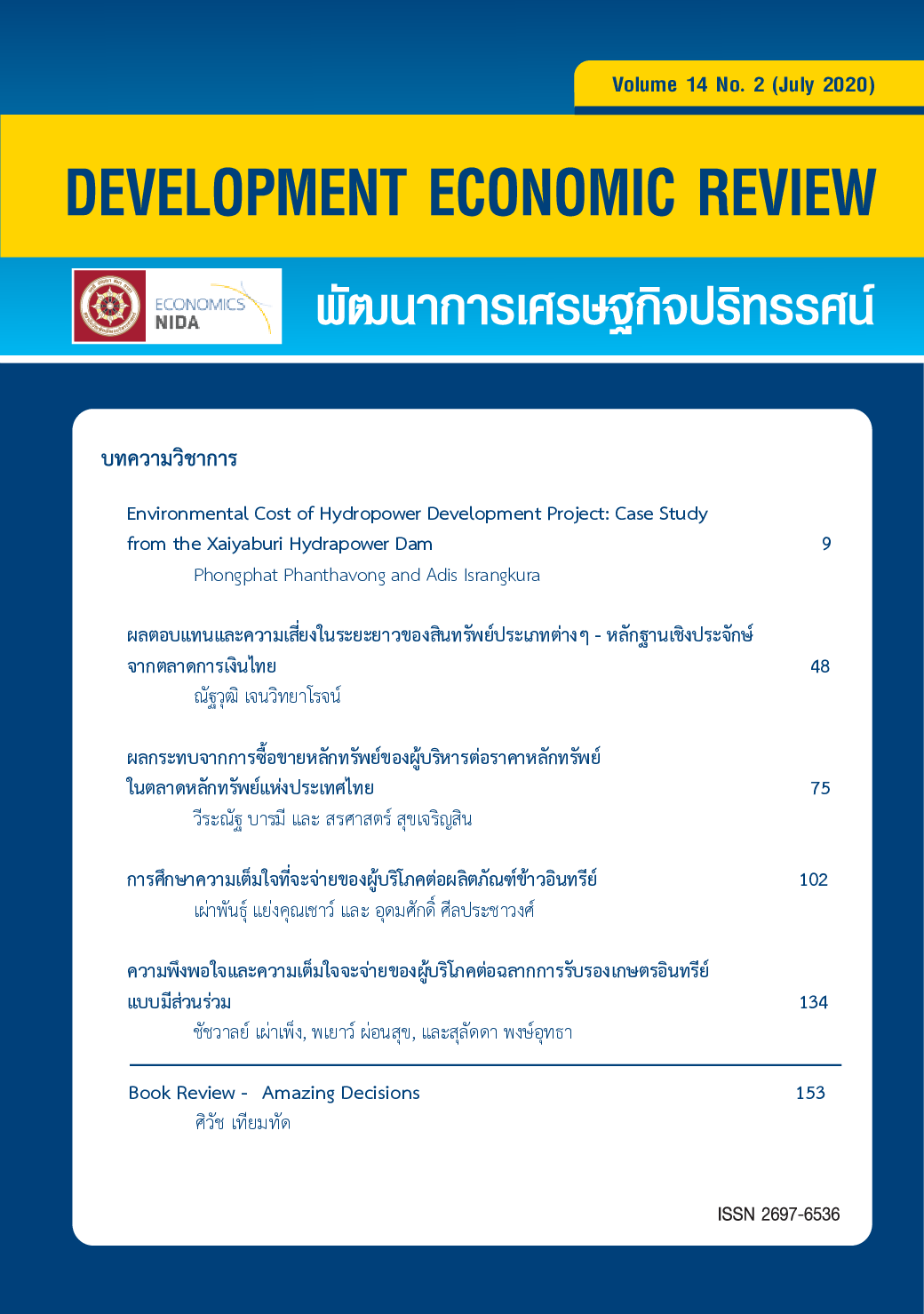ผลกระทบจากการซื้อขายหลักทรัพย์ของผู้บริหารต่อราคาหลักทรัพย์ในตลาดหลักทรัพย์แห่งประเทศไทย
คำสำคัญ:
การซื้อและขายหลักทรัพย์ของผู้บริหาร, ผลตอบแทนเกินปกติ, การศึกษาเหตุการณ์, ตลาดหลักทรัพย์แห่งประเทศไทยบทคัดย่อ
งานวิจัยนี้มีวัตถุประสงค์เพื่อศึกษาผลกระทบจากการซื้อขายหลักทรัพย์ของผู้บริหารต่อราคาหลักทรัพย์ในตลาดหลักทรัพย์แห่งประเทศไทยด้วยวิธีวิจัยแบบเหตุการณ์ศึกษา (Event Study) ซึ่งพบว่าการซื้อขายหลักทรัพย์ของผู้บริหารนั้นมีผลตอบแทนผิดปกติอย่างมีนัยสำคัญทางสถิติ โดยธุรกรรมขายนั้นจะมีอัตราผลตอบแทนกินปกติที่สูงกว่าธุรกรรมซื้อ การศึกษานี้ยังได้ขยายประเด็น การศึกษาไปถึงปัจจัยที่ส่งผลต่อความผิดปกติของราคาหลักทรัพย์ในช่วงที่มีการแจ้งธุรกรรมซื้อและขายหลักทรัพย์ของผู้บริหาร โดยพบว่าธุรกรรมการซื้อขายหลักทรัพย์ของผู้บริหารระดับสูงจะมีผลตอบแทนผิดปกติที่มากกว่าการซื้อขายหลักทรัพย์ของผู้บริหารระดับกลางอย่างมีนัยสำคัญทางสถิติ นอกจากนี้ ยังพบว่ธุรกรรมซื้อและขายหลักทรัพย์ของผู้บริหารในบริษัทขนาดใหญ่มีผลตอบแทนผิดปกติที่น้อยกว่ธุรกรรมซื้อและขายหลักทรัพย์ของผู้บริหารในบริษัทขนาดกลางและเล็ก งานวิจัยนี้ยังได้ศึกษาปัจจัยที่ส่งผลต่ออัตราผลตอบแทนผิดปกติเฉลี่ยสะสมของการซื้อและขายหลักทรัพย์ของผู้บริหารโดยใช้การประมาณค่าด้วยวิธีกำลังสองน้อยที่สุดพบว่า ขนาดและการเติบโตของกิจการ ระดับการกำกับดูแลกิจการ มีความสัมพันธ์ในเชิงผกผันกับอัตราผลตอบแทนผิดปกติเฉลี่ยสะสม
เอกสารอ้างอิง
Brown, S. J. & Warner, J. B. (1985). Using Daily Stock Returns: The Case of Event Studies. Journal of Financial Economics, 14(1), 3-31.
Charasrungrojkul, S. (2009). Corporate Governance and Insider Trading: Evidence from Thailand. Master Thesis, Faculty of Commerce and Accountancy, Chulalongkorn University. Retrieved from http://cuir.car.chula.ac.th/handle/123456789/18454.
Cohen, L., Malloy, C., & Pomorski, L. (2010). Decoding Inside Information. Journal of Financial Economics, 67(3), 1009-1043.
Dierkens, N. (1991). Information Asymmetry and Equity Issues. Journal of Financial and Quantitative Analysis, 26(2), 181–199.
Fama, E. F. (1970). Efficient Capital Markets: A Review of Theory and Empirical Work. The Journal of Finance, 25(2), 383-417.
Fang, L. & Peress, J. (2009). Media Coverage and the Cross-Section of Stock Returns, Journal of Finance, 64(5), 2023–2052.
Fidrmuc, J. P., Goergen, M., & Renneboog, L. (2006). Insider Trading, News Releases, and Ownership Concentration. Journal of Finance, 61(6), 2931-2973.
Givoly, D. & Palmon D. (1985), Insider Trading and the Exploitation of Insider Information: Some Empirical Evidence, Journal of Business, 58(1), 69-87.
Ingkasit, R. (2017). Family Affair? Insider Trading and Family Firms: Evidence from Thailand. Master Thesis, Faculty of Commerce and Accountancy, Thammasat University.
Retrieved from http://ethesisarchive.library.tu.ac.th/thesis/2017/TU_2017_5702042176_7172_4679.pdf.
Jaffe, J. F. (1974). Special Information and Insider Trading. The Journal of Business, 47(3), 410-28.
Jeng, L. A., Metrick, A., & Zeckhauser, R. (2003). Estimating the Returns to Insider Trading: A Performance-Evaluation Perspective. Review of Economics and Statistics, 85(2), 453-471.
Karpoff, J. M. (1987). The Relation between Price Changes and Trading Volume: A Survey, Journal of Financial and Quantitative Analysis, 22(1), 109-126.
Ke, B., Huddart, S. J., & Petroni, K. R. (2003). What Insiders Know About Future Earnings and How They Use it. Journal of Accounting and Economics, 35(3), 315-346.
Klassen, R. D. & McLaughlin, C.P. (1996). The Impact of Environmental Management on Firm Performance. Management Science, 42(8), 1199-214.
Lakonishok, J. & Lee, I. (2001). Are Insider Trades Informative? Review of Financial Studies, 14(1), 79-111.
Laoniramai, W. (2012). Insider Trading Behavior and News Announcement: Evidence from the Stock Exchange of Thailand. Bangkok: CMRI Working Paper 3/2013. Retrieved from
https://www.set.or.th/setresearch/files/cmresearch/2013.03_CMRI_Working_Paper.pdf.
Lhaopadchan, S., Budsaratragoon, P., & Hillier, D. (2016). Earnings Management, Corporate Governance and Insider Trading: Evidence from Thailand. Chulalongkorn Business Review, 38(3), Issue 149, 107-156.
Lin, J. C., & Howe, J. S. (1990). Insider Trading in the OTC Market. Journal of Finance, 45(4), 1273-1284.
Penman, S. (1982). Insider Trading and the Dissemination of Firms’ Forecast Information. Journal of Accounting Research, 20(2), 639-653.
Piotroski, J. D., & Roulstone, D. T. (2005). Do Insider Trades Reflect Both Contrarian Beliefs and Superior Knowledge about Future Cash Flow Realizations. Journal of Accounting and Economics, 39(1), 55-81.
Seyhun, H. (1986). Insiders’ Profits, Costs of Trading, and Market Efficiency. Journal of Financial Economics, 16(2), 189-212.
Sivakumar, K. & Waymire, G. (1994), Insider Trading Following Material News Events: Evidence from Earnings. Financial Management, 23(1), 23-32.
Sukcharoensin, S. & Sathitviangthong, S. (2012). Do Corporate Insiders have Market-Timing Ablility? Evidence from the Stock Exchange of Thailand. Journal of Financial Markets Research, 4, 6-17.
Tassaneyapong, P. & Sukcharoensin, P. (2020). Stock Price Reactions of Target Companies to Mergers and Acquisitions Announcements. Journal of Business Administration and Social Sciences, 3(1). 52-68.
Wu, Y. & Zhu, Q. (2011). When is Insider Trading Informative? SSRN Electronic Journal. Retrieved from www.researchgate.net/publication/228259458_When_is_Insider_Trading_Informative
ดาวน์โหลด
เผยแพร่แล้ว
ฉบับ
ประเภทบทความ
สัญญาอนุญาต
Copyright to published manuscripts becomes the property of the Graduate School of Development Economics, National Institute of Development Administration. Reproduction of all or part of a Development Economic Review (DER) article by anyone, excluding author(s), is prohibited, unless receiving our permission.


